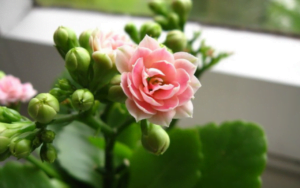Introduction
Indoor plants are the lifeline of home aesthetics and air quality, and few can match the vibrant display and easy-care nature of the Flaming Katy, or Kalanchoe blossfeldiana. This review dives deep into the essence of caring for this spectacular plant. Known for its rich, vivid blooms and succulent leaves, the Flaming Katy is a popular choice for indoor gardeners seeking to add a splash of color to their living spaces. In the following paragraphs, we embark on a comprehensive journey exploring every aspect of Flaming Katy care, ensuring your plant thrives and continues to bring joy with its dazzling display.
The key specifications for the Flaming Katy indoor plant:
| Specification | Detail |
|---|---|
| Common Names | Flaming Katy, Christmas Kalanchoe |
| Botanical Name | Kalanchoe blossfeldiana |
| Family | Crassulaceae |
| Plant Type | Perennial, Succulent |
| Mature Size | Up to 18 inches tall |
| Sun Exposure | Full sun to part shade |
| Soil Type | Well-drained, sandy or loamy |
| Soil pH | Neutral to slightly acidic |
| Bloom Time | Late fall to early spring |
| Flower Color | Red, pink, yellow, orange, white |
| Hardiness Zones | 10-12 (USDA) |
| Native Area | Madagascar |
| Benefit | Easy to care for, vibrant flowers |
Plant Care
Caring for a Flaming Katy is a delightful endeavor, where success hinges on understanding its needs. As a succulent, it’s vital to emulate its natural habitat—bright and arid. Regular care involves monitoring light exposure, watering schedules, and temperature, alongside periodic fertilization and pruning. In this review, we’ll delve into each aspect of care, ensuring even a novice gardener can cultivate a Flaming Katy to its full potential.
Light
Light is the lifeblood of the Flaming Katy. This plant prospers under bright but indirect sunlight. South-facing windows often provide the ideal amount of light—basking the plant in warmth without the harshness of direct midday rays. We’ll explore the nuances of lighting, including signs of both over and underexposure, and offer solutions to maintain the perfect balance.
Soil
The foundation of any plant’s health lies in its soil. Flaming Katy thrives in a well-draining mix, one that’s akin to its natural, rocky origin. In this section, we’ll dissect the components of the ideal soil mixture, detailing how to replicate these conditions within the confines of your home for optimum plant health.
Water
Water is a double-edged sword for many plants, and the Flaming Katy is no exception. Overwatering is a common misstep; thus, understanding the plant’s watering needs is crucial. We’ll outline a watering schedule that keeps the soil’s moisture at an optimal level, ensuring your Flaming Katy’s roots are never sitting in water, yet never too dry.
Temperature and Humidity
Succulents like the Flaming Katy prefer stability when it comes to temperature and humidity. This section discusses the ideal range and how to maintain it, mitigating any stress that fluctuations can cause. We’ll also touch upon the effects of artificial heating and cooling, providing tips to counter any negative impacts.
Fertilizer
Nutrition is essential, and fertilizing a Flaming Katy can be likened to choosing the right multivitamin. It’s not just about quantity but also about quality and timing. We’ll dive into the types of fertilizers that best suit the Flaming Katy, the frequency of application, and how to recognize signs that your plant is hungry for more—or when it’s had just enough.
Pruning
Pruning is not just about aesthetics; it’s about health. It can stimulate growth, enhance flowering, and prevent disease. This section will guide you through the best practices for pruning your Flaming Katy, ensuring each cut contributes to a more robust and visually appealing plant.
Overwintering
The chill of winter doesn’t have to spell disaster for a Flaming Katy. Overwintering involves adapting your care routine to meet the plant’s seasonal needs. We’ll outline steps to protect your plant during the colder months, ensuring its survival and continued vigor as temperatures dip.
Propagating Plant
Propagating your Flaming Katy can be an exciting way to multiply your collection or share it with friends. We’ll provide a step-by-step guide on the propagation process, from leaf cutting to the nurturing of new growth, ensuring the best chance of success.
Types of Flaming Katy
Flaming Katy (Kalanchoe blossfeldiana) showcases a diverse palette of varieties, each with its unique charm. The species itself is famed for its vibrant blooms which come in a spectrum of colors including red, pink, yellow, orange, and white. The flower shapes can also vary, from the traditional four-petaled form to double-flowered varieties that offer a more lush, opulent look.
Varieties like the ‘Calandiva’ series have double flowers, giving them an almost rose-like appearance. Others, such as ‘Queen’ series, are noted for their large, showy flowers and extended blooming period. The ‘Tessa’ variety boasts tubular flowers and a cascading growth habit, making it ideal for hanging baskets.
Each type may have slightly different care requirements, particularly when it comes to blooming and light needs, but the core care guidelines remain similar across the spectrum. Choose a variety that resonates with your personal taste and complements your living space, and you’ll find the Flaming Katy to be a remarkably adaptable and rewarding plant.
Common Pests & Plant Diseases with Solutions
Despite its hardy nature, the Flaming Katy is not immune to pests and diseases. Common pests include aphids, mealybugs, and spider mites. These pests typically attack the leaves, sucking the sap and weakening the plant.
Solutions:
- Aphids: Treat aphids by spraying the plant with a strong jet of water to knock them off or by applying insecticidal soap.
- Mealybugs: Dab individual mealybugs with alcohol using a cotton swab, or use neem oil as an organic solution.
- Spider Mites: Increase humidity around your plant and use a miticide if the infestation is severe.
Diseases often result from overwatering, leading to root rot or fungal infections. Prevent these by ensuring your soil mix is well-draining and by watering judiciously.
Solutions:
- Root Rot: Reduce watering, improve drainage, and in severe cases, repot the plant into fresh soil after removing any decayed roots.
- Fungal Infections: Improve air circulation, reduce humidity, and apply a fungicide if necessary.
How to Get Flaming Katy to Bloom
The Flaming Katy is a photoperiodic plant, meaning its blooming cycle is influenced by the length of daylight it receives. To induce blooming, the plant generally requires short daylight hours for about six weeks. Here are the steps to encourage your Flaming Katy to bloom:
- Reduce Light: Limit the plant to 8-10 hours of daylight per day for 6 weeks to mimic the natural conditions that stimulate flowering.
- Cool Temperatures: During this period, maintain cooler temperatures of around 60°F (15°C), if possible.
- Proper Rest: After the blooming period, allow the plant to rest by reducing watering and keeping it in a cooler spot.
- Resume Care: As new growth appears, resume regular care and fertilization.
Common Problems With Flaming Katy
Leggy Growth: This occurs when the plant doesn’t receive enough light. To remedy, move it to a brighter location or consider using grow lights.
Leaf Drop: Overwatering is a common cause of leaf drop. Let the soil dry out more between waterings and ensure good drainage.
Lack of Blooms: If your Flaming Katy isn’t blooming, it may be due to insufficient light or the need for a dormancy period as discussed in section M.
Burnt Leaves: Direct sunlight can sometimes be too intense, leading to scorched leaves. If this happens, move your Flaming Katy to a location with bright, indirect light.
In addressing these issues, always consider the specific conditions in your home. Flaming Katy is adaptable, but like all living things, it has its preferences and thresholds. Tailor your care to meet these needs, and you will greatly enhance the health and vitality of your plant.
Quickly Declining
Even with the best care, sometimes plants show signs of decline. This segment will tackle the common reasons why a Flaming Katy may suffer, from pests to disease, and offer actionable advice to revive your plant back to its former glory.
Flourishing Finale
In conclusion, the Flaming Katy is a resilient and rewarding plant, perfect for both seasoned gardeners and beginners. We’ll encapsulate the critical takeaways from the review, reinforcing the joy and ease of caring for this colorful succulent.
Frequently Asked Questions
Decode the magic of gardens with our guide to Landscaping Styles Frequently Asked Questions.
- Water your Flaming Katy when the top inch of soil feels dry to the touch. This typically means watering every 2-3 weeks, but always check the soil moisture first as watering needs can vary based on environmental conditions.
- Yellowing leaves can be a sign of overwatering or poor drainage. Ensure you’re not watering too frequently and that the pot allows excess water to escape.
- To encourage blooming, provide ample bright, indirect light and consider a resting period with cooler temperatures and reduced watering in the winter.
- Yes, it can be toxic when ingested. Keep it out of reach of pets and children to prevent any accidental ingestion.













